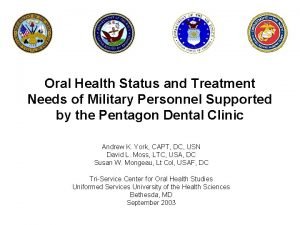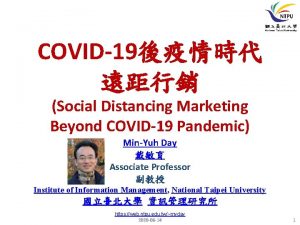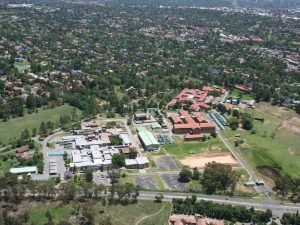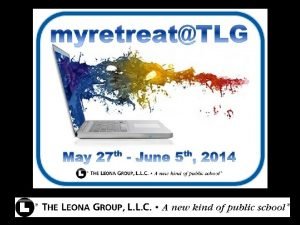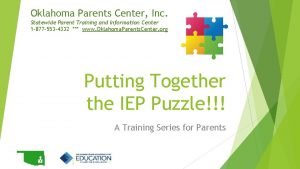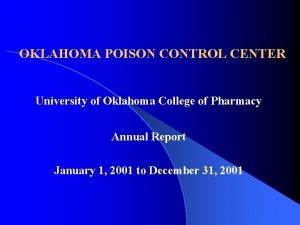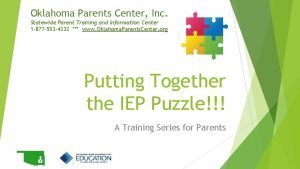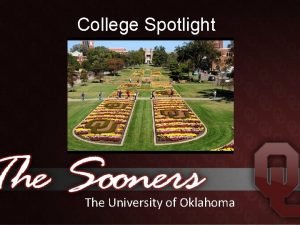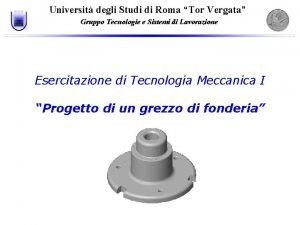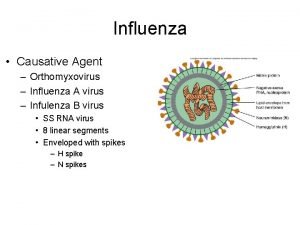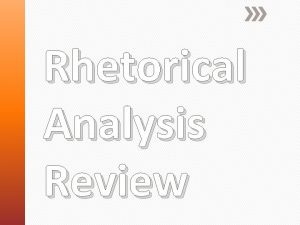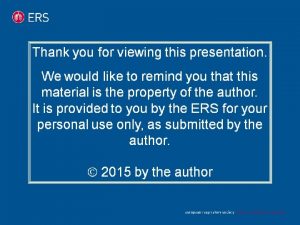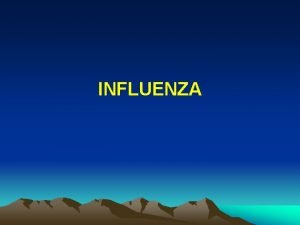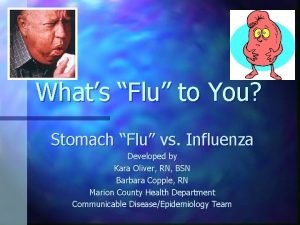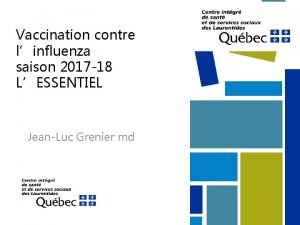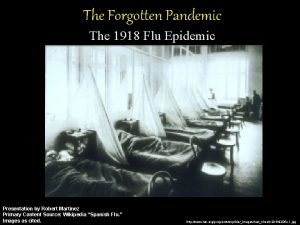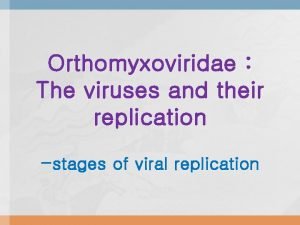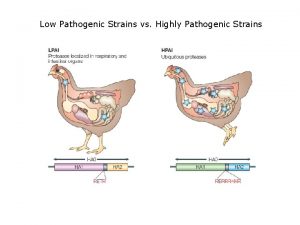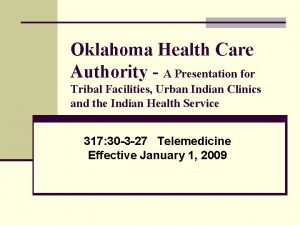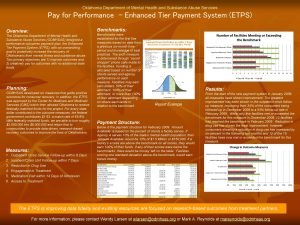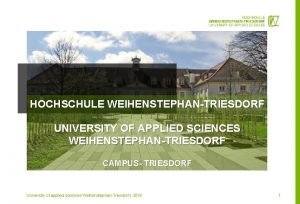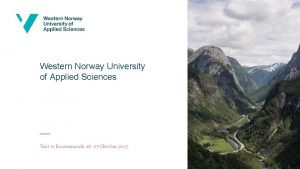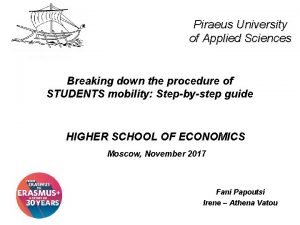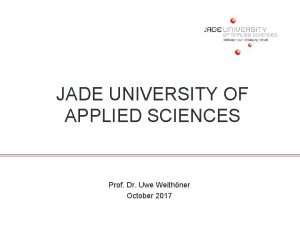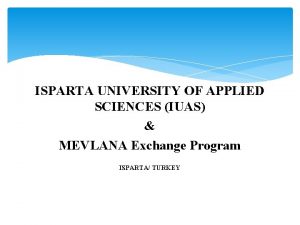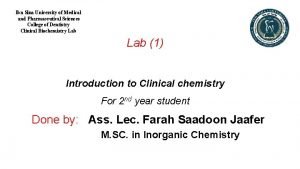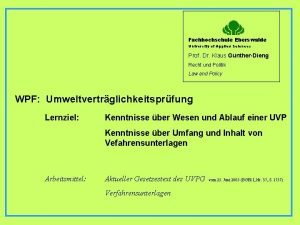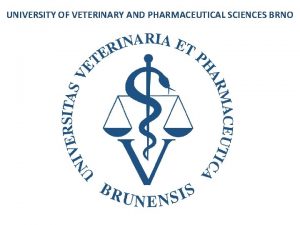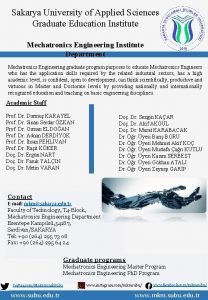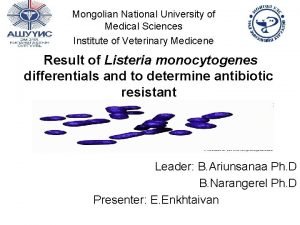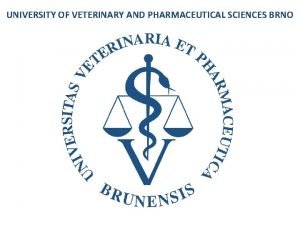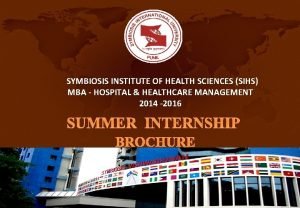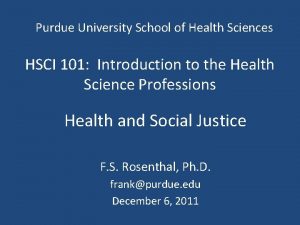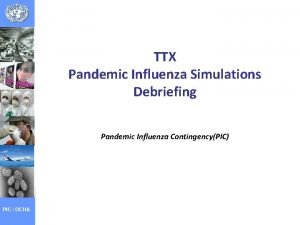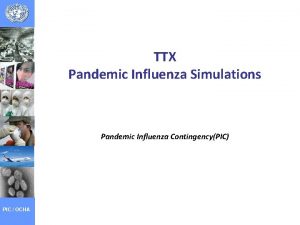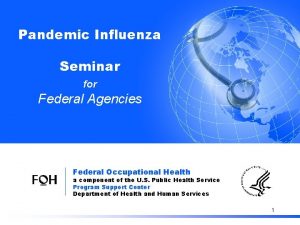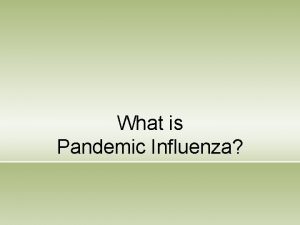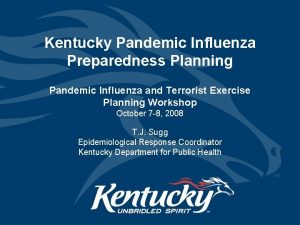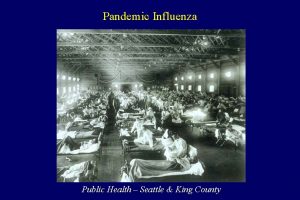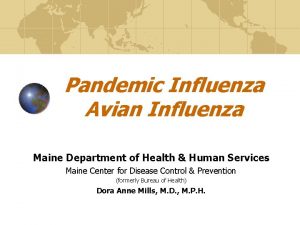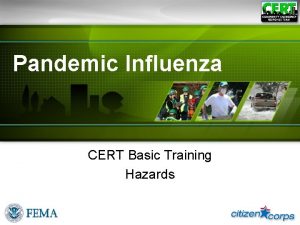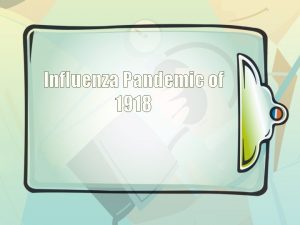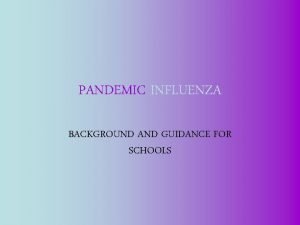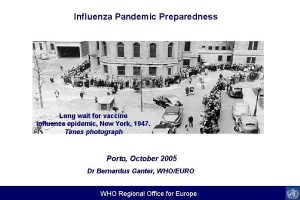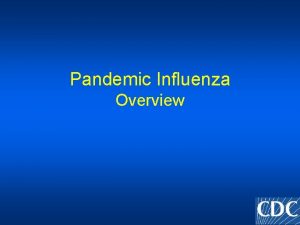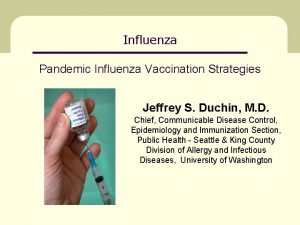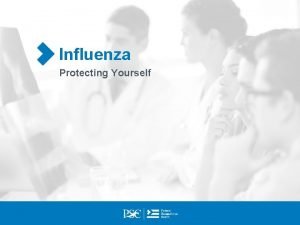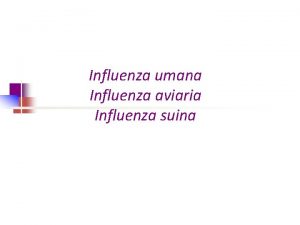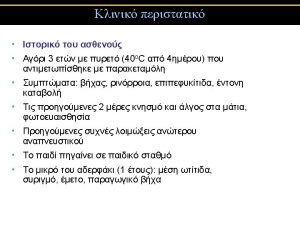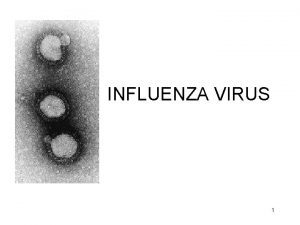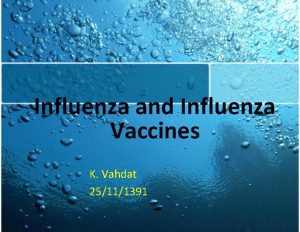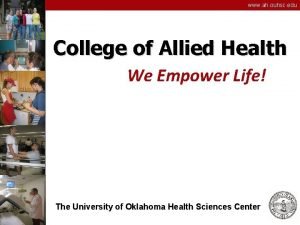UNIVERSITY OF OKLAHOMA HEALTH SCIENCES CENTER PANDEMIC INFLUENZA

















































- Slides: 49

UNIVERSITY OF OKLAHOMA HEALTH SCIENCES CENTER PANDEMIC INFLUENZA TABLETOP EXERCISE

SPONSORED BY THE SOUTHWEST CENTER FOR PUBLIC HEALTH PREPAREDNESS Adapted from an exercise developed by John Covely, Peter Reinhardt and Dave Rainer

Introduction � This exercise will focus on � Existing response plans � Legal authorities of University of Oklahoma Health Sciences Center

Introduction � A tabletop exercise � Reviews plans � Tests decision making process � Tests existing plans � A tabletop exercise is intended to � Provide a safe environment Encourage open and wide-ranging discussion � Allow for differing viewpoints and professional disagreements

Goals & Objectives � Assess validity of OUHSC’s Pandemic Influenza Response Plan � Work-at-home or administrative leave � Tele-working � Distance learning (P/VOD course casting) � Social distancing � Suspension of classes or closing University � Re-opening the University � Academic crediting

Goals & Objectives � Assess how existing emergency response structure at campus will address challenges posed by a pandemic influenza event � Travel enforcement and quarantine � Essential services and personnel � Crisis communications

Goals & Objectives � Assess how your campus will coordinate its response with your campus health service, area hospitals, and state and local public health agencies � Point of Dispensing (POD), Mass medication or vaccination dispensing � Congregate care (support for ill students remaining on campus) � Ethical and administrative issues for distribution of limited vaccination supplies

Goals & Objectives � Identify gaps and issues to be addressed in your campus response plan � Identify next steps in planning process � Business Continuity � Continuation of research � Financial implications to University � Identify training, communication and resource needs

Roles & Responsibilities � Participants � Respond to the situation Based on knowledge �Plans and procedures � Facilitators � Moderate � discussion Evaluators � Evaluate extent to which objectives were met

Exercise Conduct � � � Facilitator will introduce each module Scenario information will be provided in order in which they occur Available information will be provided to all participants Scenario will suspend for questions and discussion after each module No scheduled breaks � Allowed to leave as needed

Exercise Modules � Module 1: Sustained human-to-human transmission Module 2: Outbreak in the U. S. Module 3: Suspension of classes Module 4: Business Continuity and Recovery � Exercise Debriefing � � Player Hotwash

Ready to Begin?

Module 1 March 5 to October 11, 2009 March � During spring 2009, human cases of novel H 1 N 1 influenza first reported from Mexico � 3/5/09 Mexican Ministry of Health reports public health officials investigating hospital-associated outbreak of H 1 N 1 influenza � � U. S. government announced H 1 N 1 vaccine being rushed into development � � � Outbreak appears to be result of person-to-person transmission Likely twelve months before can be distributed Novel H 1 N 1 causes increased illness in Mexico and U. S. Unknown number of students, faculty, and staff from OUHSC & OU Norman travelling to and from Mexico

Module 1 April � 1 st case diagnosed with laboratory confirmation in U. S. � U. S. government declares novel H 1 N 1 national public health emergency � 1 st death outside of Mexico caused by novel H 1 N 1 � Centers for Disease Control and Prevention (CDC) issues Travel Health Warning for those traveling to and from Mexico � Travel Health Precaution for those traveling to South America

Module 1 June 11: World Health Organization declares influenza pandemic at level 6 June 17: CDC removes travel advisory notice regarding travel to Mexico because of cases being identified worldwide June 19: All 50 states and Puerto Rico have diagnosed at least one case of novel H 1 N 1

Module 1 July 27: Daily Oklahoman asking all Oklahoma colleges and universities to provide a copy of their Pandemic Influenza Emergency Plan to reprint in a Special Pandemic Planning Issue on August 14 th August � Cumulative number of novel H 1 N 1 cases in U. S. is estimated to exceed 1 million � � 9, 079 H 1 N 1 -related hospitalizations reported in U. S. � � 39 hospitalizations reported to OSDH 593 H 1 N 1 -related deaths reported in U. S. � � 700+ reported cases to OSDH 2 identified deaths in OK Risk factors associated with H 1 N 1 infection include: � Pregnancy, obesity, asthma, heart disease, diabetes, age < 65 years

Module 1 Aug 6: CDC detects resistance to Oseltamivir among cases previously administered doses appropriate for prophylaxis � � All novel H 1 N 1 strains are susceptible to Zanamivir All are resistant to Amantadine and Rimantadine Aug 20: CDC disseminates H 1 N 1 influenza information resources for universities and colleges Aug 31: Number of ILI-related outpatient visits in Southeastern region of U. S. equal to number of ILIrelated visits during previous peak influenza seasons Hospitalization rates among persons aged 5 -17 years and 1849 years exceeds rates during typical influenza seasons � Rates among other age groups, particularly 65+ years have rates lower than baseline �

Module 1 Sep 14 � OSU reports at least 95 cases of H 1 N 1 on campus � OU Norman reports dozens of confirmed H 1 N 1 cases on campus � USA Today reports 30, 000– 90, 000 H 1 N 1 deaths expected during 2009 -10 influenza season � Assuming � a 0. 1% case-fatality rate 20 students depart for China for some field research � Unknown number of faculty, staff, and students are traveling to various areas of world for research, meetings, conferences, etc.

Module 1 Oct 1 � CDC announces 1 dose of H 1 N 1 vaccine is sufficient to elicit a protective immune response � Vaccine � is not yet available OSDH and OUHSC begin vaccinating against seasonal flu

Discussion 1. At this stage of the scenario, what specific level of threat exists? 2. Are the pandemic influenza planning and response measures taken to date by the campus adequate and fully understood by all mission critical personnel?

Discussion 3. Review discussions regarding travelers to and from the affected areas? Points to consider include: � � � � Did OUHSC legal authority prove adequate to restrict travel? Should health concerns drive decisions related to travel, or is it appropriate for other factors to predominate? How is student, faculty, and staff travel monitored? How is this information used to enhance campus preparedness? How are affected areas defined? What are threshold criteria necessary to change existing travel policies for faculty, staff, and students? How will a restrictive travel policy affect foreign students coming from H 1 N 1 -affected areas to begin studies in Spring 2010? How will OUHSC address students, faculty, and staff returning from affected areas abroad? How will the OUHSC travel policies impact invitation of guests and visitors? Would these travel policies need to be coordinated with OCCHD and surrounding county health departments and the CDC?

Discussion 4. Is it necessary to conduct surveillance for novel H 1 N 1 on campus? Who is responsible to provide surveillance for pandemic influenza on the campus? Points to consider include: � How will the number of cases on campus affect decision making? � How will the number of cases in Oklahoma County (and surrounding counties) affect decision making? 5. Will the University publish the pandemic emergency management plan? What are the limitations, potential liabilities or legal exposure for doing so?

Module 2

Module 2 Oct 12 � Anecdotal reports from faculty and staff at OUHSC indicate influenza-related absenteeism in classes is approximately double typical influenza season and earlier than normal � � OSDH reports one pregnant student (OUHSC, College of Nursing) is in ICU with H 1 N 1 -related complications � � Typically peaks in Jan-Feb Could be more students hospitalized with H 1 N 1 not yet recognized by public health officials or university administrators OSDH reports 5 H 1 N 1 -related deaths in OK in last 2 weeks � One of which was 8 month old child of staff at OUHSC

Module 2 Oct 15: OUHSC and Norman campuses are reporting increased employee absenteeism and some employees are requesting approval to work-at-home Oct 16: first batch of H 1 N 1 vaccine is available for distribution � Approximately 25% of the total supply ordered Oct 19: Spain reports H 1 N 1 case-fatality rate in ICUs = 35% � Following countries reporting increased overall H 1 N 1 casefatality rate of 1%: � Azerbaijan, El Salvador, Laos, and Romania ≈10 times case-fatality rate previously estimated in U. S. They also report secondary attack rate ≈3 times as great as reported in U. S.

Module 2 Oct 21: Handful of students’ parents, spouses, etc, have called insisting classes be cancelled and student allowed to return home � Officials on public education boards in Tulsa encouraging schools to cancel all extra-curricular activities such as athletic events and music rehearsals Oct 23: Essentially every emergency department in Oklahoma experiencing severe crowding and is short-staffed � � � Patients are experiencing wait times up to 12 hours ≈80% of all H 1 N 1 strains in China reported to be resistant to Oseltamivir 20 students who left for China in September are scheduled to come home soon

Discussion The following questions should be considered in context of current specific level of threat as identified in emergency plan

Discussion 1. 2. 3. 4. What are the most urgent and critical impacts that need to be addressed? Do you activate your incident management system? What needs to be communicated to the students (and parents) who have decided to self-shield (selfgenerated action or actions to prevent contact or interaction with others) by leaving the campus? What needs to be communicated to the campus community and the general public? Who will craft appropriate press release information affording full disclosure of information? Does appropriate delegated authority exist for release of all necessary information to the public?

Discussion 5. 6. 7. 8. What are the policy issues for faculty and staff who want to work-at-home citing fears of being exposed to an infectious person during their incubation period? What issues or coordinating activities does the Campus Health Service need to be addressing with the state and county health departments? How do you interpret the finding that the case-fatality rate appears to be increasing in less industrialized countries? Is this sufficient evidence that the virus is mutating or is it confounded by lack of healthcarerelated resources in those countries? Will public gatherings/events be canceled, such as student socials? Who makes this decision? What are the triggers?

Discussion 9. Coach Stoops and President Boren solicit your opinion about cancelling OU football games. What is your advice? 10. What are the decision points for suspending classes or closing the University? Are you willing to set the precedent for suspending classes or are you going to wait and see what other institutions do? � What are the triggers? Number of deaths and/or cases, case-fatality rate? � Are the triggers for cancelling classes different from those to ask faculty to work from home?

Discussion 11. When should stores of anti-viral medications be dispensed? Is it time to setup a Point of Dispensing site for anti-viral medications even though the vaccine is not yet available? Who would be involved in making this decision? Who will receive the medication? 12. The Oklahoma State Regents have called the Office of the Provost requesting that facilities and vaccine supplies at the Health Sciences Center be made available, and staff provided, to include physician oversight, to vaccinate faculty, students and staff from Rose State, Oklahoma City Community College, University of Central Oklahoma, Bethany Nazarene, and Oklahoma City University. A decision and announcement is requested within 24 hours. Assurance is provided that the OSRHE will attempt to assist in securing more supplies if necessary, and will address funding issues. (Note: At this point, the decision to open a POD for OUHSC has not been made. )

Discussion 13. Should there be any travel restrictions to China? � What kind of surveillance, quarantine, or isolation measures should be undertaken for the students returning home from China? 14. Does the Incident Command Team have the authority to acquire more resources (medical supplies, security, personnel, etc)? 15. What authorities are in place or need to be developed to handle the above issues? 16. Do you have a liaison officer with the Oklahoma State Department of Health (OSDH)?

Module 3

Module 3 � Oct 25: CDC reports receiving numerous strains of H 1 N 1 from countries across world that have a key mutation allowing virus to infect deeper into lung � This evidence supports a true increase in mortality associated with H 1 N 1 Severity Summer ‘ 09 Fall ‘ 09 Asymptomatic 15% 5% Mild 35% 20% Typical 40% 45% Severe 10% 30%

Module 3 Oct 27 � Governor Henry orders public school system (K-6) be closed and recommends that all other grades also suspend classes � OSU suspends classes � OUHSC General Administration indicates that as many as 45% of all employees are refusing to return to work, either because of illness, selfshielding, or caring for young children/ill family members � OU Medical Center, VA, and our campus health service report being besieged with calls and people worried about their symptoms

Module 3 Nov 2 � Essential personnel are ordered to report for work; over several days, at any given time, only 35% of the total required workforce reports � Researchers are demanding access to their research facilities, complaining that critical experiments, health of research animal, activities, etc, are in jeopardy and express concern that funding could be threatened if not allowed to continue their efforts.

Module 3 Nov 6 � Next batch of H 1 N 1 vaccine (additional 35% of total order) is available for distribution through a POD � � If decision is made to support other colleges & universities in area, will vaccine be shared? Healthcare workers & essential personnel prioritized for vaccination � OCCHD asked campus administration designate additional personnel who may receive vaccination before dispensing through POD Incident Response Team, in concert with administration, submits list of personnel to OCCHD to receive vaccination � � � Shipments of food and other essentials delayed because national transportation network has been decimated by absenteeism 8 deaths have been reported on university campuses in OK and hundreds of students lie ill within their dormitory rooms and residences CDC estimates H 1 N 1 vaccine has approximately 70% efficacy in persons with normal immune systems

Discussion 1. If you didn’t cancel classes or close the University in Module 2, do you do so now? To what extent will you use capabilities for videostreaming lectures so that students don’t miss out on course work? What are the key factors in making decisions related to this area? b) How will you address missed work for courses requiring in-class participation (i. e. , courses that aren’t amenable to watching video-streamed lectures? ) a)

Discussion 2. Do you setup a Point of Dispensing (POD) for your Mass Immunization/Prophylaxis Site (MIPS) for vaccination given you only have 35% of the total order? Do you still dispense anti-viral medications? a) If yes, who do you ask to be involved? a) Will you involve students (medical, nursing, and public health) who have volunteered to be involved?

Discussion 3. What are the issues regarding essential personnel who refuse to show up for work? 4. What business continuity planning clause might affect vendors who don't deliver? 5. What mechanisms are in place to deal with contract operations that fail to meet conditions and requirements, especially those identified as critical to continued operations of the HSC?

Discussion 6. Hospital and campus clinic capacity has been rapidly exceeded. How is their status being monitored? What approaches to managing surge capacity will be used? Are all necessary authorities in place to deal with the full range of surge capacity issues? 7. Are you concerned about the lack of food and medication supplies being delivered to the campus? If yes, what plans do you have to secure food and/or medical supplies? 8. Do you require those employees critical to maintaining the operation of the campus to wear N-95 masks while at work? a) If there are shortages of N-95 masks, do you still require them to show-up for work?

Discussion 9. What mechanisms are in place to address mental health issues for students, faculty, and staff? (Potential issues include death/hospitalization of loved-ones, stress related to postponing graduation, missed work, etc. )

Module 4 Nov. 8 � Daily Oklahoman and Tulsa World report nearly 2000 people have died in Oklahoma and 180, 000 nationwide � � Fewer than half of essential personnel employees are showing up for work and supply is critically low � � Double earlier predictions Human Resources is trying to identify employees who may have recovered from flu in order to re-supply numbers of essential personnel Notification is made for essential POD personnel to report to campus on Tuesday � Many are hard to locate and POD Administrator worries insufficient personnel to staff it

Module 4 Nov. 9 � POD is activated � Not enough personnel to run it at designated rate � Hundreds of people are waiting to get into facility � POD personnel are shaken by some security breaches � People are getting unruly � � Parents and students demanding refunds of tuition until University re-opens Area hospitals refusing to accept any more patients since hospital and Alternate Care Facility overwhelmed � They asked state for permission to utilize more rooms to expand their capacity

Module 4 Nov. 16 � National media reporting first wave is subsiding � Hospitals throughout state are reporting a rapid decline in number of new cases Nov. 20 � President Obama appears on national television to announce that CDC and WHO have concluded First Wave is nearly over, but warns a Second Wave could appear in two to three months

Discussion 1. 2. 3. 4. What alternate care facilities have been identified? How will they be staffed? What are the ethical and administrative guidelines for selecting those for vaccination? How do Human Resources identify those who have recovered from the flu? Will students, faculty, staff be required to have medical clearance to return to campus? If so, who monitors?

Discussion 5. 6. 7. 8. 9. What policy covers those students and employees who refuse to return to campus until they feel it is safe to return? How can your campus identify more Point of Dispensing (POD) personnel and also maintain security at the POD? What public information/risk communication is being conveyed? What are the issues regarding tuition reimbursements, credits, etc? What are the triggers to reopen classes?

Debriefing

Debriefing 1. 2. 3. 4. Identify the three most important activities accomplished during this tabletop exercise. What are three most important gaps identified during this exercise? What are three most important lessons learned from participating in this exercise? Identify three things that could help improve this exercise.
 University of health sciences lahore events
University of health sciences lahore events Pentagon dental clinic
Pentagon dental clinic Facultad de ciencias de la salud uma
Facultad de ciencias de la salud uma University of central florida health care administration
University of central florida health care administration Human sciences
Human sciences Covid 19 pandemic summary
Covid 19 pandemic summary Interpandemic
Interpandemic Pandemic tabletop exercise template
Pandemic tabletop exercise template Mathalicious pandemic answer key
Mathalicious pandemic answer key Who pip framework
Who pip framework Oklahoma parents center
Oklahoma parents center Poison control oklahoma
Poison control oklahoma Oklahoma parents center
Oklahoma parents center The university of oklahoma colors cream
The university of oklahoma colors cream Piano di divisione delle staffe
Piano di divisione delle staffe Causative agent
Causative agent The great influenza rhetorical analysis
The great influenza rhetorical analysis Influenza
Influenza Influenza
Influenza Stomach flu vs influenza
Stomach flu vs influenza Is influenza a airborne disease
Is influenza a airborne disease Rimantidina
Rimantidina Influenza vaccine dosage chart 2019-2020
Influenza vaccine dosage chart 2019-2020 Influenza ww1
Influenza ww1 Influenza virus replication
Influenza virus replication Low pathogenic avian influenza
Low pathogenic avian influenza Oklahoma health care authority
Oklahoma health care authority Oklahoma department of mental health
Oklahoma department of mental health National center for theoretical sciences
National center for theoretical sciences Van hall larenstein, university of applied sciences
Van hall larenstein, university of applied sciences Vaasa university of applied sciences
Vaasa university of applied sciences Oulu university of applied sciences
Oulu university of applied sciences Ima hswt
Ima hswt Kodolan
Kodolan Western norway university of applied sciences
Western norway university of applied sciences Piraeus university of applied sciences
Piraeus university of applied sciences Jade university of applied sciences
Jade university of applied sciences Isparta university of applied sciences
Isparta university of applied sciences Ibn sina university of medical and pharmaceutical sciences
Ibn sina university of medical and pharmaceutical sciences Eberswalde university of applied sciences
Eberswalde university of applied sciences University of veterinary and pharmaceutical sciences brno
University of veterinary and pharmaceutical sciences brno University of kragujevac faculty of technical sciences
University of kragujevac faculty of technical sciences Mischhybrid
Mischhybrid International university of applied sciences bad honnef
International university of applied sciences bad honnef Sakarya university of applied sciences
Sakarya university of applied sciences Mongolian national university of medical sciences
Mongolian national university of medical sciences Veterinary and pharmaceutical university brno
Veterinary and pharmaceutical university brno Pirkanmaan ammattikorkeakoulu
Pirkanmaan ammattikorkeakoulu Symbiosis hospital management
Symbiosis hospital management Purdue health sciences
Purdue health sciences

